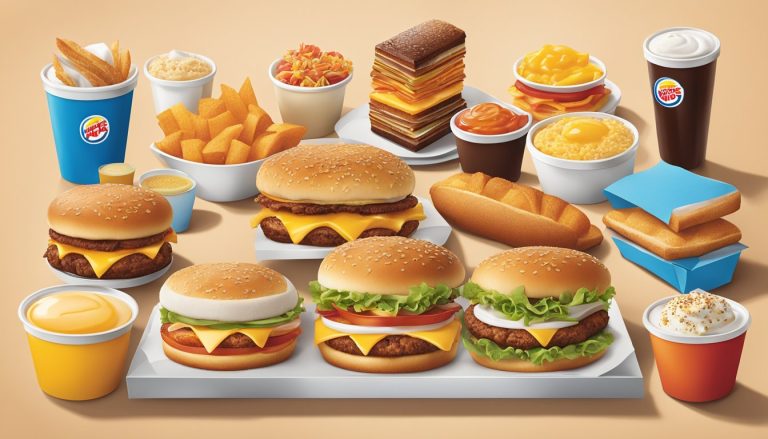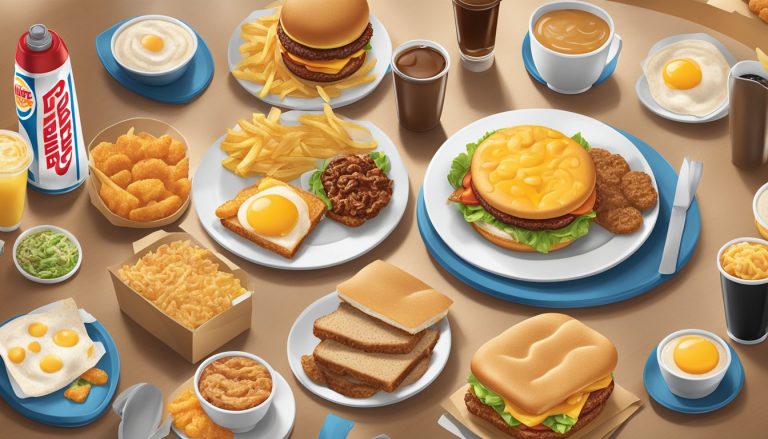Burger King’s breakfast menu pricing reflects a strategic approach to capturing the morning market. The fast-food giant offers a range of options priced from $1.00 to $6.89, catering to different customer preferences and budgets. Burger King’s breakfast pricing strategy aims to balance affordability with profitability, positioning itself competitively in the crowded fast-food breakfast sector.
Popular items like the Croissan’wich and Biscuit Sandwich start at $2.99, while more substantial options such as the Pancake & Sausage Platter are priced at $3.69. This tiered pricing allows BK to appeal to cost-conscious consumers while also offering premium selections for those willing to spend more. The economics behind these prices take into account factors such as ingredient costs, labor, and market demand.
BK’s breakfast menu also includes combo meals and value options, providing customers with perceived savings when purchasing bundled items. This pricing structure encourages higher spending per transaction while maintaining the perception of value. As the fast-food breakfast market continues to evolve, Burger King’s pricing strategy remains a key factor in its ability to compete and maintain profitability in this crucial daypart.
Historical Context of Burger King’s Breakfast Menu

Burger King’s journey into the breakfast market marked a significant shift in fast food dynamics. The introduction and evolution of their morning offerings reflected changing consumer preferences and competitive pressures in the industry.
Inception of BK’s Breakfast Offerings
Burger King entered the breakfast arena in the late 1970s, following McDonald’s lead in capturing the morning customer base. The initial launch faced challenges due to equipment limitations. BK’s signature flame broilers, central to their brand identity, proved unsuitable for many breakfast items.
This technological hurdle delayed the full rollout of Burger King’s breakfast menu until 1979. The company invested time and resources to develop equipment and recipes tailored for morning fare.
Evolution of Breakfast Items over Time
Burger King’s breakfast menu underwent significant changes since its inception. In 1985, BK introduced the “Am Express” product line, diversifying its morning offerings beyond basic items.
Over the years, the menu expanded to include a variety of sandwiches, platters, and coffee options. BK adapted to consumer trends, introducing healthier choices and value-oriented deals.
The introduction of the breakfast value menu in the early 2000s aimed to compete with other chains and attract cost-conscious customers. This strategy helped boost morning sales and increase foot traffic during breakfast hours.
Analyzing BK’s Breakfast Menu Structure

Burger King’s breakfast menu offers a diverse array of options to cater to different customer preferences. The menu is structured around key categories and signature items that form the core of BK’s morning offerings.
Breakfast Items and Categories
Burger King’s breakfast menu is divided into several distinct categories. Breakfast Platters provide hearty options for those seeking a full meal. These include combinations of pancakes, eggs, and meats. Breakfast Sandwiches form a significant portion of the menu, featuring items like the Croissan’wich and Biscuit Sandwich. These start at $2.99 and offer various protein choices.
Coffee Options are a crucial component, with BK Café Coffee priced at $2.69. The menu also includes lighter fare and sides to complement main dishes. Prices range from budget-friendly options starting at $1 to more substantial meals.
Signature Breakfast Products
BK’s breakfast menu is anchored by several signature items that set it apart from competitors. The Croissan’wich, a portmanteau of croissant and sandwich, is a flagship product. It combines flaky pastry with eggs, cheese, and choice of meat.
Another standout is the Pancake & Sausage Platter, priced at $3.69. This classic combination appeals to those seeking a traditional breakfast experience. The BK Café line extends beyond basic coffee, offering specialty drinks to compete with coffee shop offerings.
Unique items like the Cheesy Onion on Rye Bread showcase BK’s efforts to diversify its menu. These signature products aim to create brand loyalty and differentiate Burger King in the competitive fast-food breakfast market.
BK’s Breakfast Pricing Strategy

Burger King employs a strategic approach to pricing its breakfast menu items. The company balances cost considerations with competitive positioning to attract customers while maintaining profitability.
Factors Affecting Menu Pricing
Ingredient costs play a crucial role in determining breakfast item prices at Burger King. The chain sources eggs, meats, and bread products in large quantities to keep expenses down. Labor costs for early morning staff also factor into pricing decisions.
Burger King uses a tiered pricing structure for its breakfast menu. Value items like hash browns start at $1, while premium options like the Croissan’wich range from $2.99 to $4.59. This allows BK to cater to budget-conscious customers and those willing to spend more.
Market demand influences pricing as well. Popular items may command slightly higher prices due to their appeal. Seasonal promotions and limited-time offers often feature special pricing to drive sales during specific periods.
Comparative Pricing with Competitors
Burger King aims to position its breakfast prices competitively against other fast food chains. The company’s breakfast combo meals typically range from $4 to $7, aligning closely with similar offerings from McDonald’s and Wendy’s.
BK’s $1 value menu items provide a low-cost entry point, matching competitors’ budget options. Mid-range items like the Bacon, Egg & Cheese Biscuit at $4.59 are priced similarly to equivalent products at other chains.
Burger King occasionally undercuts competitors on certain items to gain a price advantage. For example, BK’s large coffee at $2.69 is often priced lower than comparable sizes at Starbucks or Dunkin’.
The chain also uses bundled meal deals to offer perceived value. Breakfast combos include hash browns and coffee, allowing customers to save compared to purchasing items separately.
Market Demand and Consumer Behavior
Breakfast menu pricing at Burger King is heavily influenced by consumer behavior and market demand. These factors shape the fast-food chain’s strategies to maximize profitability while meeting customer needs.
Time of Day and Purchase Patterns
Breakfast hours significantly impact consumer behavior at Burger King. The peak morning rush typically occurs between 7 AM and 9 AM on weekdays. During this time, customers prioritize quick service and portable menu items.
Burger King adapts its pricing to reflect these patterns. Lower-priced combo meals are often featured to attract budget-conscious commuters. The chain may offer time-limited promotions, such as discounted coffee before 10 AM.
Purchase patterns also vary by day of the week. Weekends see a shift towards later breakfast times and larger group orders. Burger King adjusts its menu and pricing accordingly, emphasizing family-friendly options and all-day breakfast items.
Demographics and Customer Preferences
Burger King’s breakfast menu caters to diverse demographics, each with distinct preferences. Young professionals often seek healthier options like yogurt parfaits or egg white sandwiches. The chain prices these items competitively to capture this health-conscious segment.
Families represent a key demographic for breakfast sales. Burger King offers value meals and kids’ options to appeal to this group. Pricing strategies include bundled deals that provide savings on multiple items.
Senior citizens form another important customer base. They tend to prefer traditional breakfast fare and value for money. Burger King addresses this through affordable classic menu items and senior discounts during breakfast hours.
The fast-food chain also considers regional preferences in its pricing strategy. In areas with high demand for specific items, such as biscuit sandwiches in the Southern United States, Burger King may adjust prices to reflect local tastes.
Operational Costs and Profit Margins
Breakfast restaurant economics hinge on balancing operational expenses with menu pricing to achieve healthy profit margins. Labor and ingredients form the core of these costs, while margins can vary significantly across different breakfast items.
Ingredient and Labor Costs
Fast food breakfast menus rely heavily on eggs, bread, meats, and coffee. These ingredients typically account for 25-35% of a menu item’s price. Labor costs for breakfast service often range from 20-30% of sales. Cooks and other staff must be efficient to keep labor expenses in check.
BK optimizes costs by bulk purchasing and streamlining food prep. They use pre-cooked bacon and pre-sliced cheese to reduce kitchen labor. Automated equipment like conveyor toasters helps minimize staffing needs.
To control expenses, BK carefully monitors food waste and adjusts ordering based on sales forecasts. They also cross-train employees to handle multiple stations, improving labor flexibility during busy periods.
Margins Across Different Breakfast Items
Coffee and other beverages often have the highest profit margins, sometimes exceeding 80%. Basic egg sandwiches typically yield 50-60% margins. More complex items like breakfast platters may have lower margins of 30-40% due to higher ingredient costs.
BK strategically prices items to balance profitability with customer value. They may offer loss leaders like $1 coffee to drive traffic, making up profits on other menu items. Combo meals help increase average check size and overall margins.
Seasonal promotions and limited-time offers allow BK to test new items and price points. They analyze sales data to optimize their menu mix for maximum profitability while meeting customer demands.
Marketing and Promotions

Burger King employs targeted strategies to boost breakfast sales and engage customers during the morning rush. The fast-food chain leverages digital platforms and promotional offers to entice early diners and drive traffic to its restaurants.
Targeted Advertising for the Morning Rush
Burger King focuses on capturing the attention of commuters and early risers through strategic advertising placements. Billboard ads near highways and transit stations highlight breakfast menu items and limited-time offers. Radio spots during morning drive times remind listeners about BK’s breakfast options. The chain also utilizes social media platforms to share eye-catching images of breakfast sandwiches and coffee drinks, targeting users scrolling through their feeds in the early hours.
Digital display ads on news websites and weather apps further reinforce Burger King’s breakfast messaging to those starting their day online. These targeted approaches aim to position BK as a convenient and appealing breakfast destination for busy consumers.
Promotional Deals and Digital Exclusives
The BK App plays a crucial role in Burger King’s breakfast marketing strategy. App users gain access to exclusive breakfast deals and discounts not available in-store. These digital promotions often include:
- Buy-one-get-one free offers on breakfast sandwiches
- Discounted combo meals featuring coffee and hash browns
- Limited-time menu items available only through the app
Burger King also runs periodic breakfast promotions across its digital channels. These may include:
- Free coffee with any breakfast purchase
- Reduced prices on popular items like Croissan’wiches
- Loyalty program points for breakfast orders
By offering these digital exclusives, Burger King incentivizes app downloads and repeat visits while collecting valuable customer data to refine its marketing efforts.
Impact of Third-Party Delivery Services

Third-party delivery services have significantly altered BK’s breakfast menu pricing and operations. These platforms have introduced new cost considerations and customer engagement opportunities.
Partnerships and Pricing Adjustments
BK has formed partnerships with major delivery services to expand its breakfast reach. These collaborations often require pricing adjustments to account for commission fees and delivery costs. Menu items like BK Café Iced Coffee may see price increases of 10-20% on delivery apps compared to in-store prices.
Delivery services typically charge restaurants 15-30% commission per order. To maintain profitability, BK has implemented strategies such as offering delivery-exclusive promotions and bundled deals. This helps offset fees while driving order volume.
Some locations have created separate breakfast menus for third-party platforms. These curated offerings focus on items that travel well and maintain quality during delivery.
Customer Experience and Retention
Third-party delivery has expanded BK’s breakfast customer base. Many consumers now expect the convenience of having their morning meals delivered. This shift has impacted how BK approaches customer retention.
Delivery apps provide valuable data on ordering patterns and preferences. BK uses these insights to refine its breakfast menu and target promotions. For example, they may notice increased demand for BK Café Iced Coffee during certain time slots.
Quality control becomes more challenging with delivery. BK has implemented special packaging for breakfast items to maintain temperature and freshness. They also work closely with delivery partners to minimize errors and ensure timely service.
Customer feedback through delivery apps helps BK quickly identify and address issues. This rapid response capability is crucial for maintaining satisfaction in the competitive breakfast market.
Consumer Trends and Health Consciousness

Health-conscious consumers are reshaping fast food breakfast menus. This shift impacts pricing strategies and product offerings, with a focus on plant-based options and nutritional transparency.
Shift Towards Plant-Based Options
Fast food chains are expanding their plant-based breakfast selections to meet growing demand. BK introduced the Impossible Croissan’wich, featuring a plant-based sausage patty. This move caters to vegans, vegetarians, and flexitarians seeking meatless alternatives.
Plant-based options often carry higher price points due to ingredient costs and perceived value. Consumers show willingness to pay more for these health-oriented choices.
The Impossible Whopper’s success at lunch and dinner paved the way for plant-based breakfast items. This trend reflects broader consumer interest in sustainable and ethical food choices.
Nutrition and Calorie Awareness
Calorie counts and nutritional information now prominently feature on BK’s breakfast menu. This transparency helps health-conscious customers make informed decisions.
BK offers lower-calorie options like egg white sandwiches and oatmeal. These items are priced competitively to attract health-focused consumers without alienating value-seekers.
Nutritional information impacts menu design and pricing. Items perceived as healthier may command slight premiums, reflecting their appeal to health-conscious segments.
BK balances healthier options with indulgent classics to cater to diverse consumer preferences. This strategy aims to maintain broad appeal while addressing health trends.
Future Outlook and Expansion Opportunities

Burger King’s breakfast menu pricing strategy is poised for significant evolution. The company aims to leverage its global presence and innovative product development to drive growth in the breakfast segment.
International Markets and Adaptation
Burger King plans to expand its breakfast offerings across international markets. The chain will tailor its menu to local tastes and preferences in each region. In China, for example, BK may introduce rice-based breakfast items alongside traditional Western options.
The company is eyeing growth in countries with developing economies, where rising middle classes present new opportunities. Burger King’s adaptable pricing model will allow for market-specific strategies, balancing affordability with profitability.
New Product Development
BK’s research and development team is focusing on innovative breakfast items to attract new customers and increase sales. The chain is exploring plant-based alternatives to appeal to health-conscious consumers.
Seasonal limited-time offers are expected to drive excitement and foot traffic. Burger King may introduce regional specialties as part of its breakfast menu to cater to local tastes.
The company is also investing in technology to improve ordering efficiency and reduce wait times during peak breakfast hours. This includes mobile app enhancements and in-store kiosk upgrades.




